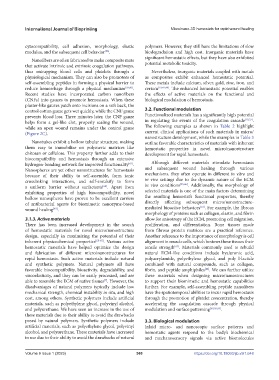Page 368 - IJB-9-1
P. 368
International Journal of Bioprinting Micro/nano-3D hemostats for rapid wound healing
cytocompatibility, cell adhesion, morphology, elastic polymers. However, they still have the limitations of slow
modulus, and the subsequent cell behavior . biodegradation and high cost. Inorganic materials have
[56]
Nanofibers are often fabricated to make composite mats significant hemostatic effects, but they have also exhibited
that activate intrinsic and extrinsic coagulation pathways, potential metabolic toxicity.
thus entrapping blood cells and platelets through a Nevertheless, inorganic materials coupled with metals
physiological mechanism. They can also be promotors of as composites exhibit enhanced hemostatic potential.
self-assembling peptides in forming a physical barrier to These metals include calcium, silver, gold, zinc, iron, and
reduce hemorrhage through a physical mechanism [59,60] . cerium [19,41,49] . The enhanced hemostatic potential enables
Recent studies have incorporated carbon nanofibers the effects of active materials on the functional and
(CNFs) into gauzes to promote hemostasis. When these biological modulation of hemostasis.
plaster-like gauzes patch onto incisions on a rat’s back, the
control cotton gauze gets wet quickly, while the CNF gauze 3.2. Functional modulation
prevents blood loss. Three minutes later, the CNF gauze Functionalized materials has a significantly high potential
helps form a gel-like clot, properly sealing the wound, in regulating the events of the coagulation cascade [19,37] .
while an open wound remains under the control gauze The following examples as shown in Table 2 highlight
(Figure 2C). current clinical applications of such materials in micro/
nanostructure development, while the examples in Table 3
Nanotubes exhibit a hollow tubular structure, making outline favorable characteristics of materials with inherent
them easy to immobilize on polymeric matrices like hemostatic properties in novel micro/nanostructure
chitosan or cellulose. This property further adds to their development for rapid hemostasis.
biocompatibility and hemostasis through an extensive
hydrogen-bonding network for improved functionality . Although different materials stimulate hemostasis
[61]
Nanospheres are yet other nanostructures for hemostasis and subsequent wound healing through various
because of their ability to self-assemble, form ionic mechanisms, they often operate in different in vitro and
crosslinking interactions, and self-emulsify to form in vivo settings due to the dynamic nature of the ECM
[45,66]
a uniform barrier without surfactants . Apart from in vivo conditions . Additionally, the morphology of
[62]
exhibiting properties of high biocompatibility, novel selected materials is one of the main factors determining
hollow nanospheres have proven to be excellent carriers the resulting hemostat’s functional properties, thereby
of antibacterial agents for biomimetic nanozyme-based directly affecting subsequent micro/nanostructure-
[16]
wound healing . mediated bioactive behaviors . For example, the fibrous
[49]
morphology of proteins such as collagen, elastin, and fibrin
3.1.3. Active materials allow for anisotropy of the ECM, promoting cell migration,
There has been increased development in the search proliferation, and differentiation. Bone tissues made
of hemostatic materials for novel micro/nanostructure from fibrous protein matrices are a practical reference.
design, especially in maximizing the potential of their Another reference to the importance of morphology is cell
inherent physicochemical properties [63-65] . Various active alignment in muscle cells, which bestows these tissues their
hemostatic materials have helped optimize the design tensile strength . Materials commonly used to rebuild
[67]
and fabrication of different micro/nanostructures for natural ECM-like conditions include hyaluronic acid,
rapid hemostasis. Such active materials include natural polyacrylamide, polyethylene glycol, and poly l-lactide
and synthetic polymers. Natural polymers all have combined with natural compounds, such as collagen,
favorable biocompatibility, bioactivity, degradability, and fibrin, and peptide amphiphiles . We can further utilize
[44]
viscoelasticity, and they can be easily processed, and are these materials when designing micro/nanostructures
able to resemble the ECM of native tissues . However, the to support their biomimetic and hemostatic capabilities
[7]
disadvantages of natural polymers typically include low further. For example, self-assembling peptide nanofibers
mechanical strength, chemical instability in situ, and high have the spatiotemporal abilities to incur rapid hemostasis
cost, among others. Synthetic polymers include artificial through the promotion of platelet concentration, thereby
materials, such as polyethylene glycol, polyvinyl alcohol, accelerating the coagulation cascade through physical
and polyurethane. We have seen an increase in the use of modulation and surface patterning [60,68,69] .
these materials due to their ability to avoid the drawbacks
posed by natural polymers. Synthetic polymers include 3.3. Biological modulation
artificial materials, such as polyethylene glycol, polyvinyl Inlaid micro- and nanoscopic surface patterns and
alcohol, and polyurethane. These materials have increased hemostatic agents respond to the body’s biochemical
in use due to their ability to avoid the drawbacks of natural and mechanosensory signals via active biomolecules
V
Volume 9 Issue 1 (2023)olume 9 Issue 1 (2023) 360 https://doi.org/10.18063/ijb.v9i1.648

